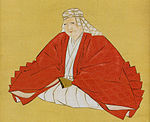Chidorigafuchi National Cemetery
Buildings and structures in Chiyoda, TokyoCemeteries in JapanGeographic coordinate listsLists of coordinatesNational cemeteries ... and 1 more
Tourist attractions in Tokyo

Chidorigafuchi National Cemetery (千鳥ケ淵戦没者墓苑, Chidorigafuchi Senbotsusha Boen) is a national Japanese cemetery and memorial for 352,297 unidentified war dead of the Second World War, located near the inner moat of the Imperial Palace and Yasukuni Shrine in Tokyo, Japan.
Excerpt from the Wikipedia article Chidorigafuchi National Cemetery (License: CC BY-SA 3.0, Authors, Images).Chidorigafuchi National Cemetery
CHIDORIGAFUCHI RYOKUDO, Chiyoda
Geographical coordinates (GPS) Address Nearby Places Show on map
Geographical coordinates (GPS)
| Latitude | Longitude |
|---|---|
| N 35.69 ° | E 139.74694444444 ° |
Address
六角堂
CHIDORIGAFUCHI RYOKUDO
102-8381 Chiyoda
Japan
Open on Google Maps










